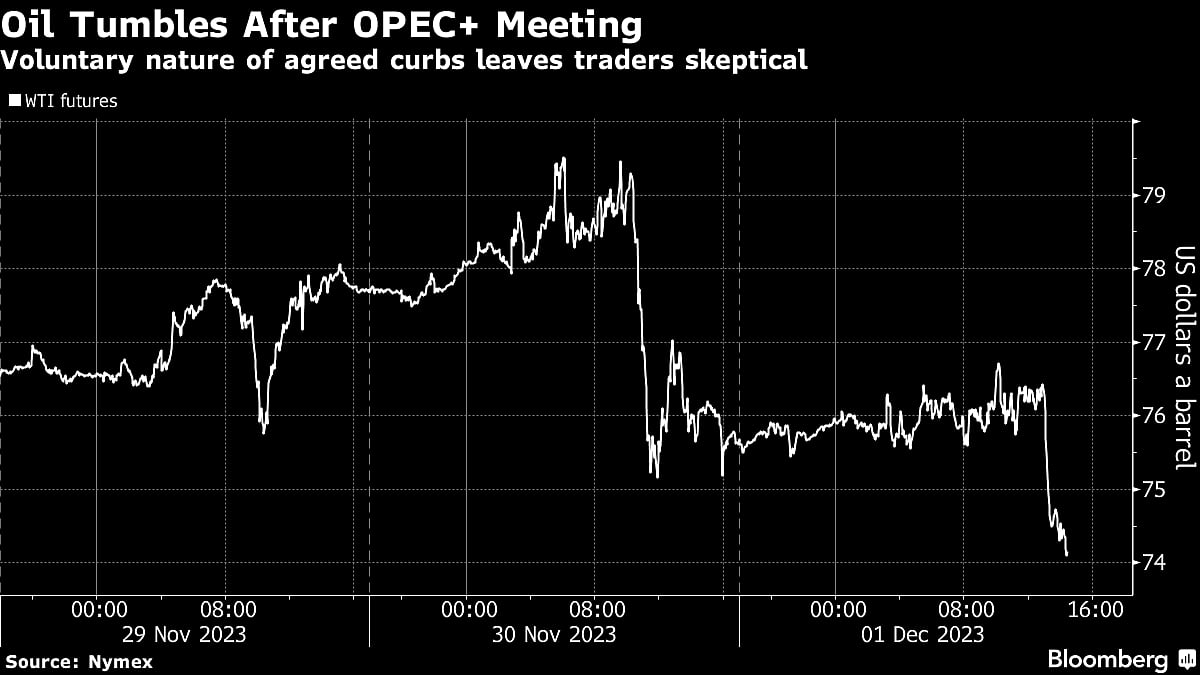Even OPEC Output Cuts Are Powerless to Stop Oil’s Six-Week Slide
Track the latest crude prices here.

(Bloomberg) -- Oil extended declines, closing out a sixth straight weekly drop, as the OPEC+ output cuts announced Thursday failed to dispel the market’s gloom over swelling global supplies.
West Texas Intermediate dropped 2.5% to settle near $74 a barrel, following a 2.4% slide in the previous session. The alliance announced roughly 900,000 barrels a day of fresh output cuts next year, but the curbs are voluntary, with Angola already rejecting its quota. In the US, the oil rig count increased by five in the most recent week, signaling a continued increase in the country’s already-record output.
Read More: OPEC+ ‘Voluntary’ Oil Output Cuts Fail to Convince Traders
Algorithmic selling played a heavy hand in crude’s steep descent on Friday, with intraday models triggering selling once WTI and Brent fell through key technical levels of $75 and $80, respectively, late in the session. About 5,000 lots of $40/$30 bearish put spreads in ICE WTI for June traded on Friday as traders sought protection against a massive slide in prices. Low volumes typical for end-of-week trading also contributed to the choppy trading.

Crude initially climbed Thursday as the production cartel’s preliminary agreement looked likely to help stem an anticipated surplus at the start of next year. That optimism quickly faded amid a lack of clarity from the meeting and doubts over whether the cuts would be fully implemented.
“Market concerns about compliance may be overblown, but poor communication from the OPEC+ meeting contributed to the downside in oil markets over the last sessions,” said Daniel Ghali, a commodity strategist at TD Securities. “However, as the dust settles, we estimate that the agreement may nonetheless be sufficient to skirt an expected surplus over the coming months.”
The US benchmark ended the week down almost 2% following the OPEC+ rollercoaster, remaining in the range it has traded in for much of November. Prices have moved into a lower band than in previous months as surging supplies outside of the producer group risk a market surplus in the first quarter.
Read More: Skepticism and Confusion: What Analysts Say About the OPEC+ Cuts

Meanwhile, Brazil — which has contributed to the increase in global supplies — said it would join the OPEC+ alliance cooperation charter next year, but won’t take part in any production cuts for now.
The outcome of the OPEC+ meeting was a “confusing, entangled mess,” Vandana Hari, founder of Vanda Insights, said in a Bloomberg TV interview. “These are all still voluntary cuts, and that’s one of the reasons for the disappointment,” she said, adding that whether the extra 900,000 barrels a day of additional curbs are delivered over the first quarter remains to be seen.
More stories like this are available on bloomberg.com
©2023 Bloomberg L.P.